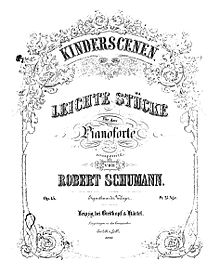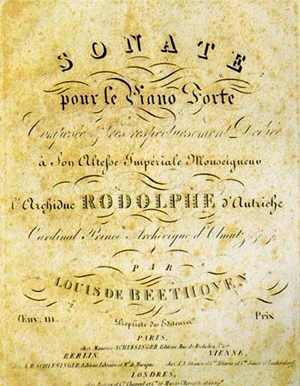| Catalogue No. | Title | Year of composition | Publication details | Notes |
|---|
| Op. 1 | Variations on the name "Abegg" | 1830 | Kistner, Leipzig, November 1831 | |
| Op. 2 | Papillons | 1829–1831 | Kistner, Leipzig, February/March 1832 | |
| Op. 3 | Etudes after Paganini Caprices | 1832 | Hofmeister, Leipzig, August 1832 | |
| Op. 4 | Intermezzi | 1832 | Hofmeister, Leipzig, September 1833 | |
| Op. 5 | Impromptus on a theme of Clara Wieck | 1833, revised 1850 | Hofmeister, Leipzig, September 1833; [note 2] revision also published by Hofmeister | |
| Op. 6 | Davidsbündlertänze | 1837, revised 1850 | Friese, Leipzig, January 1838; revision published by Schuberth, Hamburg and Leipzig | |
| Op. 7 | Toccata in C major | 1830-4 | Hofmeister, Leipzig, early 1834 | |
| Op. 8 | Allegro in B minor | 1831 | Friese, Leipzig, end of 1834/beginning of 1835 | |
| Op. 9 | Carnaval | 1834–1835 | Breitkopf & Härtel, Leipzig, July 1837 | |
| Op. 10 | 6 Concert Studies on Caprices by Paganini | 1833 | Hofmeister, Leipzig, September 1835 | |
| Op. 11 | Grand Sonata No. 1 in F-sharp minor | 1835 | Kistner, Leipzig, June 1836 | |
| Op. 12 | Fantasiestücke | 1837 | Breitkopf & Härtel, Leipzig, February 1838 | |
| RSW:op12:Anh (H/K WoO 28) | Supplement to the Op. 12 Fantasiestücke | 1837 | Modern publication | A piece withdrawn from publication by Schumann at the final redaction of the Fantasiestücke |
| Op. 13 | Études symphoniques | 1834-6, revised 1852 | Haslinger, Vienna, May 1837; revision published by Schuberth, Hamburg and Leipzig | |
| RSW:op13:Anh:1-5 (H/K WoO 6) | Symphonic Etudes in Variation Form | 1837 | Modern publication | Five supplementary variations to Op.13, often performed as part of the main work |
| Op. 14 | Grand Sonata No. 3 in F minor ("Concerto without Orchestra") | 1835-6, revised 1853 | First edition as Concert sans Orchestre by Haslinger, Vienna, September 1836; revision issued as Grande Sonate by Schuberth, Hamburg and Leipzig | |
| RSW:op14:Anh:1 (H/K WoO 5,1) | Scherzo | 1835-36 | Modern publication | Rejected from the Op. 14 Sonata |
| Op. 15 | Kinderszenen | 1838 | Breitkopf & Härtel, Leipzig, March 1839 | |
| Op. 16 | Kreisleriana | 1838, revised 1850 | Haslinger, Vienna, September 1838; revision published by Whistling, Leipzig | |
| Op. 17 | Fantasie in C | 1836, revised 1839 | Breitkopf & Härtel, Leipzig, April 1839 | |
| Op. 18 | Arabeske in C | 1839 | Mechetti [ de ], Vienna, August 1839 | |
| Op. 19 | Blumenstück in D-flat | 1839 | Mechetti [ de ], Vienna, August 1839 | |
| Op. 20 | Humoreske in B-flat | 1839 | Mechetti [ de ], Vienna, August 1839 | |
| Op. 21 | Novelletten | 1838 | Breitkopf & Härtel, Leipzig, June 1839 | |
| Op. 22 | Sonata No. 2 in G minor | 1833–1835 | Breitkopf & Härtel, Leipzig, September 1839 | |
| RSW:op22:Anh (H/K WoO 5,2) | Presto passionato | 1835 | Modern publication | Original finale for Sonata No. 2 Op. 22 |
| Op. 23 | Nachtstücke | 1839 | Mechetti [ de ], Vienna, June 1840 | |
| Op. 26 | Faschingsschwank aus Wien | 1839 | Mechetti [ de ], Vienna, August 1841 | |
| Op. 28 | 3 Romanzen | 1839 | Breitkopf & Härtel, Leipzig, October 1840 | |
| Op. 32 | 4 Klavierstücke (Scherzo, Gigue, Romance and Fughette) | 1838–1839 | Schuberth, Hamburg and Leipzig, February/March 1841 | |
| Op. 56 | Etuden in kanonischer Form für Orgel oder Pedalklavier | 1845 | Whistling, Leipzig, September 1846 | |
| Op. 58 | Skizzen für Orgel oder Pedalklavier | 1845 | Kistner, Leipzig, August 1846 | |
| Op. 60 | 6 Fugen über den Namen Bach für Orgel oder Pedalklavier | 1845 | Whistling, Leipzig, November 1846 | |
| Op. 68 | Album für die Jugend | 1848 | Schuberth, Hamburg and Leipzig, end of 1849; reissued December of the following year, unrevised but with a new text appendix | |
| RSW:op68:Anh:9,10,13,14 (H/K WoO 16) | Additional pieces to Album für die Jugend Op. 68 | 1848 | Modern publication | |
| RSW:op68:Anh:1,3,6,9,10,13,14,16-18,21,24,26,27 (H/K WoO 30) | Additional pieces to Album für die Jugend Op. 68 | 1848 | Modern publication | |
| Op. 72 | 4 Fugues | 1845 | Whistling, Leipzig, September 1850 | |
| Op. 76 | 4 Marches | 1849 | Whistling, Leipzig, August 1849 | |
| Op. 82 | Waldszenen | 1848–1849 | Senff, Leipzig, November 1850 | |
| Op. 99 | Bunte Blätter | 1836–1849 | Arnold, Elberfeld, December 1851 | |
| Op. 111 | Three Fantasiestücke, Op. 111 | 1851 | Peters, Leipzig, July 1852 | |
| Op. 118 | 3 Piano Sonatas for the Young | 1853 | Schuberth, Hamburg and Leipzig, December 1853 | |
| Op. 124 | Albumblätter | 1832–1845 | Arnold, Elberfeld, December 1853 | |
| Op. 126 | 7 Pieces in Fughetta Form | 1853 | Arnold, Elberfeld, May 1854 | |
| Op. 133 | Gesänge der Frühe | 1853 | Arnold, Elberfeld, November 1855 | |
| RSW:Anh:F2 | Romanze in F minor | 1829 | Modern publication | Fragment |
| RSW:Anh:F7 | Variations in G on an original theme, "“Mit Gott”" | 1831-32 | Modern publication | Fragment |
| RSW:Anh:F8 | Introduction, Theme, and Sketches for 4 variations on a theme of Paganini’s “La Campanella” in B minor | 1831-32 | Modern publication | Unfinished |
| RSW:Anh:F11 | Exercise fantastique | 1832 | | Lost |
| RSW:Anh:F12 | Étude fantastique | 1830-32 | | Lost |
| RSW:Anh:F14 | 12 Burlesken (or Burlen und Papilloten) | 1832 | Modern publication | Fragments |
| RSW:Anh:F15 | Fandango in F-sharp minor | 1832 | Modern publication | Some material from this was reused in the Op. 11 Sonata |
| RSW:Anh:F18 | Fantasie satyrique, after Henri Herz | 1832 | Modern publication | Fragment |
| RSW:Anh:F19 | 8 Fugen und Kanons | 1832-33 | Modern publication | |
| RSW:Anh:F19,8 (H/K WoO 4) | Canon on F.H. Himmel's "An Alexis send' ich dich" in A flat major | 1832-33 | Modern publication | |
| RSW:Anh:F24 | Variationen über den “Sehnsuchtswalzer” von Franz Schubert in A-flat major | 1831-34 | Modern publication | Unfinished. The opening was reused in No. 1 from Carnaval, Op. 9 |
| RSW:Anh:F25 (H/K WoO 31) | 15 Studies in the Form of Free Variations on a Theme by Beethoven | 1833–1835 | Modern publication: Henle, Munich 1976 | The theme is the opening of the Allegretto from Beethoven's seventh symphony |
| RSW:Anh:F26 | Variations on a nocturne by Chopin in G minor | 1835-36 | Modern publication | Incomplete. The theme is Chopin's nocturne Op. 15, No. 3) |
| RSW:Anh:F28 | Sonata No.4 in F minor | 1833-37 | Modern publication | Unfinished |
| RSW:Anh:F39 (H/K WoO 24) | Thema mit Variationen (Geistervariationen) | 1854 | Modern publication: Hinrichsen, London, 1939 | |



